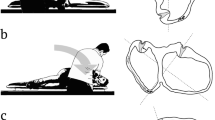Abstract
Purpose
To document the effect of cupula deflection in Benign Paroxysmal Positional Vertigo (BPPV) through the measured Vestibulo-Ocular Reflex (VOR) gain in individual semi-circular canals.
Methods
A literature search using the Preferred Reporting Items for Systematic Reviews and Meta-Analyses guidelines was performed on December 30, 2020. The following terms were entered in the title, abstract, and keywords in the electronic databases of PubMed, Scopus, Web of Science, and Cochrane Library search engines in different combinations: “Benign Paroxysmal Positional Vertigo” or “Benign Positional Vertigo” or “BPPV,” and “Video Head Impulse” or “vHIT”. All types of studies were included in the initial search. An additional inclusion criterion was the presence of numerical values of VOR gains of the tested canals in the reports.
Results
A total of 122-screened articles were obtained from the electronic database search. Finally, the authors settled on five original articles for meta-analysis with a total of 168 patients (123 with posterior canal BPPV, 28 with lateral canal BPPV, and 17 with anterior canal BPPV) and 85 controls. The main outcomes of these studies comprised the VOR gains of the lateral, posterior, and anterior SCCs on the affected side relative to that in the contralesional side, and/or healthy controls.
Conclusion
This meta-analysis shows that vHIT can be valuable as a supporting test in the diagnosis of BPPV, especially for posterior canal BPPV.




Similar content being viewed by others
References
Hotson JR, Baloh RW (1998) Acute vestibular syndrome. N Engl J Med 339(10):680–685
Furman JM, Cass SP (1999) Benign paroxysmal positional vertigo. N Engl J Med 341(21):1590–1596
Vibert D, Kompis M, Hausler R (2003) Benign paroxysmal positional vertigo in older women may be related to osteoporosis and osteopenia. Ann Otol Rhinol Laryngol 112(10):885–889
Jeong SH, Choi SH, Kim JY, Koo JW, Kim HJ, Kim JS (2009) Osteopenia and osteoporosis in idiopathic benign positional vertigo. Neurology 72(12):1069–1076
Bhattacharyya N, Baugh RF, Orvidas L, Barrs D, Bronston LJ, Cass S et al (2008) Clinical practice guideline: benign paroxysmal positional vertigo. Otolaryngol Head Neck Surg 139(5 Suppl 4):S47-81
Roberts RA, Gans RE, Kastner AH, Listert JJ (2005) Prevalence of vestibulopathy in benign paroxysmal positional vertigo patients with and without prior otologic history. Int J Audiol 44(4):191–196
Singh NK, Govindaswamy R, Jagadish N (2019) Test-Retest Reliability of Video Head Impulse Test in Healthy Individuals and Individuals with Dizziness. J Am Acad Audiol 30(9):744–752
Alhabib SF, Saliba I (2017) Video head impulse test: a review of the literature. Eur Arch Otorhinolaryngol 274(3):1215–1222
Bayram A, Kaya A, Ody MM, Hira İ, Tofar M, Özcan I (2017) Clinical practice of horizontal video head impulse test in healthy children. Kulak Burun Bogaz Ihtis Derg 27(2):79–83
Tamas LT, Obrist D, Avan P, Buki B (2019) Biasing the semicircular canal cupula in excitatory direction decreases the gain of the vestibuloocular reflex for head impulses. J Vestib Res 29(6):281–286
Moher D, Liberati A, Tetzlaff J, Altman DG (2010) Preferred reporting items for systematic reviews and meta-analyses: The PRISMA statement. Int J Surg 8(5):336–341
Perez-Fernandez N, Martinez-Lopez M, Manrique-Huarte R (2014) Vestibulo-ocular reflex in patients with superior semicircular canal benign paroxysmal positional vertigo (BPPV). Acta Otolaryngol 134(5):485–490
Fallahnezhad T, Adel Ghahraman M, Farahani S, Hoseinabadi R, Jalaie S (2017) Vestibulo-ocular reflex abnormalities in posterior semicircular canal benign paroxysmal positional vertigo: a pilot study. Iran J Otorhinolaryngol 29(94):269–274
Guan Q, Zhang L, Hong W, Yang Y, Chen Z, Zhang D et al (2017) Video head impulse test for evaluation of vestibular function in patients with vestibular neuritis and benign paroxysmal positional vertigo. Zhejiang Da Xue Xue Bao Yi Xue Ban 46(1):52–58
Cinar Y, Bayram A, Culfa R, Mutlu C (2018) Analyses with the video head impulse test during the canalith repositioning maneuver in patients with isolated posterior semicircular canal benign paroxysmal positional vertigo. Turk Arch Otorhinolaryngol 56(2):81–84
Salturk Z, Yetiser S (2020) Video head impulse testing in patients with benign paroxysmal positional vertigo. Acta Otolaryngol 140(12):977–981
Sonu P, Sujata S, Jagriti B, Rekha C (2015) Benign paroxysmal positional vertigo: pathophysiology, Causes, Canal Variants and Treatment. Int J Adv Res 3(7):54–60
Yusuf Çınar AB, Culfa R, Mutlu C (2018) Analyses with the video head impulse test during the canalith repositioning maneuver in patients with isolated posterior semicircular canal benign paroxysmal positional vertigo. Turk Arch Otorhinolaryngol 56(2):81–84
Tamas LT, Lundberg YW, Buki B (2018) Vergence increases the gain of the human angular vestibulo-ocular reflex during peripheral hyposensitivity elicited by cold thermal irrigation. J Vestib Res 27(5–6):265–270
Honrubia V, House M (2001) Mechanism of posterior semicircular canal stimulation in patients with benign paroxysmal positional vertigo. Acta Otolaryngol 121(2):234–240
Parnes LS, Agrawal SK, Atlas J (2003) Diagnosis and management of benign paroxysmal positional vertigo (BPPV). CMAJ 169(7):681–693
Mantokoudis G, Tehrani AS, Xie L, Eibenberger K, Eibenberger B, Roberts D et al (2016) The video head impulse test during post-rotatory nystagmus: physiology and clinical implications. Exp Brain Res 234(1):277–286
Author information
Authors and Affiliations
Corresponding author
Additional information
Publisher's Note
Springer Nature remains neutral with regard to jurisdictional claims in published maps and institutional affiliations.
Rights and permissions
About this article
Cite this article
Elsherif, M., Eldeeb, D. & Eldeeb, M. Clinical significance of video head impulse test in benign paroxysmal positional vertigo: a meta-analysis. Eur Arch Otorhinolaryngol 278, 4645–4651 (2021). https://doi.org/10.1007/s00405-021-06832-3
Received:
Accepted:
Published:
Issue Date:
DOI: https://doi.org/10.1007/s00405-021-06832-3




